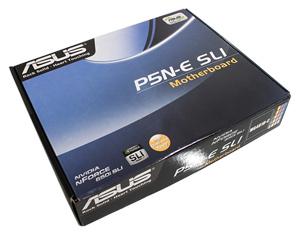Asus P5N-E SLI Nvidia nForce 650i SLI
Introduction and Specifications
Nvidia's newly launched nForce 680i SLI for Intel's Core 2 processors is undoubtedly the most lavish, extravagant, and exiting chipset currently on the market. This chipset, which we recently looked at in depth with our review of the high-end Asus Striker board, features such features like DDR-1200 memory support, triple PCI Express x16 sized slots, 16 x 16 SLI support, and it's designed specifically for the ultra high-end gamer. Nvidia released this high-end chipset first in order to provide attention to their product line, which certainly worked well. Now that Nvidia has arguably supplanted Intel's 975X as the most desirable chipset on the market, they are rounding out their product line with the release of their less feature packed and more budget friendly options, the nForce 650i SLI and nForce 650 Ultra.
Like Nvidia's product lines of the past, the mid-range SLI and mid-range (non-SLI) products are largely based on the high-end chipset, but are stripped down in order to keep costs down. For the most part, the nForce 650i series offers the same core features, benefits, and drawbacks which the nForce 680i has, but does so at a much lower price point. While no one likes having features stripped out, what Nvidia has taken out of the 680i chipset in order to make the 650i a reality is quite reasonable - and the end result is a chipset which creates less heat, consumes less power, performs nearly identically, and costs quite a bit less.

|

|
The core differences are these. The nForce 650i SLI, which is what we'll be looking here today, only supports 8 x 8 SLI, rather than the full 16 x 16 SLI on the nForce 680i. The nForce 650i also does not support Nvidia's LinkBoost technology (automatic PCIe overclocking with nVidia GPU's), nor does the 650i support DualNet (dual Gigabit Ethernet links + linking dual NICs together) and cannot support a third PCI Express graphics slot due to its fewer PCI Express lanes. Beyond these four features, the 650i and the 680i are virtually identical. Therefore, if you're like many users and don't need SLI x16 support, don't need multiple NIC's and can do overclocking the manual way, well, the nForce 650i is a much better value. Today we'll be looking at the premiere nForce 650i SLI platform on the market, the new Asus P5N-E SLI. This board has garnered a lot of attention lately, both positive from overclockers and negative from those claiming it was rushed out too quickly. Let's see what this board is capable of.
Specifications:

|
CPU
Chipset
Front Side Bus
Memory
Expansion Slots
Scalable Link Interface (SLI)
Storage
LAN
Audio
IEEE 1394a
USB
Overclocking Features
BIOS
|
Manageability
Special Features
Back Panel I/O Ports
Internal I/O Connectors
Accessories
Software
Form Factor
|







